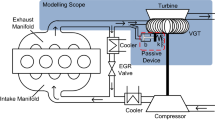Abstract
Current diesel engines commonly employ a variable geometry turbocharger (VGT) to improve drivability and fuel efficiency, and this paper addresses model-based feedforward control of the VGT based on empirical models of compressor and turbine efficiencies to improve transient response. Though compressor and turbine efficiencies affect compressor air flow and turbine power, respectively, it is challenging to understand exactly the compressor and turbine efficiencies in real engines. In order to cope with this problem, we propose empirical models of compressor and turbine efficiencies. The input states are proposed based on maps of the compressor and turbine efficiencies, which are provided by turbocharger manufacturers. Parameters of the efficiency models are identified with 225 data of steady-state engine experiments to reflect engine operating conditions. The proposed compressor and turbine efficiency models were applied to the model-based VGT feedforward control algorithm to verify the effectiveness of the efficiency models. The proposed modelbased VGT feedforward control algorithm based on the compressor and turbine efficiency models was experimentally verified with 2.2 L common-rail-direct-injection diesel engines.
Similar content being viewed by others
Abbreviations
- c p :
-
specific heat at constant pressure [kJ/kgK]
- η :
-
efficiency [-]
- h :
-
specific enthalpy [kJ/kg]
- J :
-
moment of inertia [kJ/s 2 ]
- K :
-
specific heat ratio [-]
- N :
-
rotational speed [rev/s]
- P :
-
pressure [kPa]
- P wr :
-
power [kJ/s]
- R :
-
gas constant [kJ/kgK]
- T :
-
temperature [K]
- u :
-
position [%]
- V :
-
volume [m 3 ]
- W :
-
mass flow rate [kg/s]
References
Chauvin, J., Corde, G., Petit, N. and Rouchon, P. (2008). Motion planning for experimental airpath control of a diesel homogeneous charge-compression ignition engine. Control Engineering Practice, 16, 1081–1091.
Desantes, J. M., Arr Gle, J., Molina, S. and Lejeune, M. (2000). Influence of the EGR rate, oxygen concentration and equivalent fuel/air ratio on the combustion behaviour and pollutant emissions of a heavy-duty diesel engine. CEC/SAE Spring Fuels & Lubricants Meeting & Exposition. Paris, France, SAE.
Eriksson, L., Wahlstr, M. J. and Klein, M. (2010). Physical Modeling of Turbocharged Engines and Parameter Identification. Luigi del Re, F. A., Luigi, G., Carlos, G., Ilya, K. (edn.) Automotive Model Predictive Control. Berlin / Heidelberg. Springer.
Filipi, Z., Wang, Y. and Assanis, D. (2004). Variable geometry turbine (VGT) strategies for improving diesel engine in-vehicle response: A simulation study. Int. J. Heavy Vehicle Systems, 11, 303–326.
Garcia-Nieto, S., Martinez, M., Blasco, X. and Sanchis, J. (2008). Nonlinear predictive control based on local model networks for air management in diesel engines. Control Engineering Practice, 16, 1399–1413.
Guzzella, L. and Amstutz, A. (1998). Control of diesel engines. IEEE Control Systems Magazine, 18, 53–71.
Guzzella, L. and Onder, C. H. (2004). Introduction to Modeling and Control of Internal Combustion Engine Systems. Berlin. Springer.
Jankovic, M. and Kolmanovsky, I. (2000). Constructive Lyapunov control design for turbocharged diesel engines. IEEE Trans. Control Systems Technology, 8, 288–299.
Jensen, J. P., Kristensen, A. F., Sorenson, S. C., Houbak, N. and Hendricks, E. (1991). Mean value modeling of a small turbocharged diesel engine. SAE Paper No. 910070.
Jung, M. (2003). Mean-Value Modelling and Robust Control of the Airpath of a Turbocharged Diesel Engine. Degree of Doctor of Philosophy. University of Cambridge.
Jung, M. and Glover, K. (2006). Calibratable linear parameter-varying control of a turbocharged diesel engine. IEEE Trans. Control Systems Technology, 14, 45–62.
Jung, M., Glover, K. and Christen, U. (2005). Comparison of uncertainty parameterisations for H∞ robust control of turbocharged diesel engines. Control Engineering Practice, 13, 15–25.
Kao, M. and Moskwa, J. J. (1995). Turbocharged diesel engine modeling for nonlinear engine control and state estimation. J. Dynamic Systems, Measurement and Control, Trans. ASME, 117, 20–30.
Lee, K., Park, I., Sunwoo, M. and Lee, W. (2013). AUTOSAR-ready light software architecture for automotive embedded control systems. Trans. KSAE, 21, 68–77.
Moraal, P. and Kolmanovsky, I. (1999). Turbocharger modeling for automotive control applications. SAE Papers No. 1999-01-0908.
Nelson, S. A., Filipi, Z. S. and Assanis, D. N. (2003). The use of neural nets for matching fixed or variable geometry compressors with diesel engines. J. Engineering for Gas Turbines and Power, 125, 572–579.
Oh, B., Lee, M., Park, Y., Won, J. and Sunwoo, M. (2013). Mass air flow control of common-rail diesel engines using an artificial neural network. Proc. Institution of Mechanical Engineers, Part D: J. Automobile Engineering, 227, 299–310.
Omran, R., Younes, R. and Champoussin, J. C. (2009). Optimal control of a variable geometry turbocharged diesel engine using neural networks: Applications on the ETC test cycle. IEEE Trans. Control Systems Technology, 17, 380–393.
Ortner, P. and Del Re, L. (2007). Predictive control of a diesel engine air path. IEEE Trans. Control Systems Technology, 15, 449–456.
Park, I., Lee, W. and Sunwoo, M. (2012). Application software modeling and integration methodology using AUTOSAR-ready light software architecture. Trans. KSAE 20, 6, 117–125.
Stefanopoulou, A. G., Kolmanovsky, I. and Freudenberg, J. S. (2000). Control of variable geometry turbocharged diesel engines for reduced emissions. IEEE Trans. Control Systems Technology, 8, 733–745.
Van Nieuwstadt, M. J., Kolmanovsky, I. V., Moraal, P. E., Stefanopoulou, A. and Jankovic, M. (2000). EGR-VGT control schemes: Experimental comparison for a highspeed diesel engine. IEEE Control Systems Magazine, 20, 64–79.
Wang, J. (2008). Hybrid robust air-path control for diesel engines operating conventional and low temperature combustion modes. IEEE Trans. Control Systems Technology, 16, 1138–1151.
Watson, N. and Janota, M. S. (1982). Turbocharging the Internal Combustion Engine. Macmillan Publishers Ltd. Southampton.
Author information
Authors and Affiliations
Corresponding author
Rights and permissions
About this article
Cite this article
Park, Y., Park, I., Min, K. et al. Model-based feedforward control of the VGT in a diesel engine based on empirical models of compressor and turbine efficiencies. Int.J Automot. Technol. 16, 561–570 (2015). https://doi.org/10.1007/s12239-015-0057-7
Received:
Revised:
Accepted:
Published:
Issue Date:
DOI: https://doi.org/10.1007/s12239-015-0057-7



